This year I have two awards for what seems to be the same thing: a Most Valuable Player and a Best Player. What the heck is the difference? The time frame is the difference.
The Best Player Plaque is based on one season of data, while the Most Valuable Player Trophy is based on three seasons of data. It takes time to prove value. A player having his first good season does not yet have significant value, as he hasn’t yet proved that what he has done is a true indication of his abilities.
In this article, I will identify this season’s MVP and the runners-up. I will then finish by showing the MVP leaders from the start of the “rich-statistics era”, which began in 2007-08.
But first, let’s take a closer look at the Value Rating statistic.
Value Rating – Noah Dobson (D, NYI)
There are two criteria a player must meet in order to receive a value rating.
First, he must have played at least one game in the season. Jonathan Toews (F, CHI) did not play in 2020-21 and thus had no Value Rating that season.
Second, he must have played at least half of the games in the previous three seasons. Jonathan Toews played 124 total games in 2021-22 and 2022-23, which is one more than necessary to qualify for a Value Rating even though he played only two of the three seasons.
Value Rating is a weighted average of the Productivity Ratings from the previous three seasons. The season weights are 5, 4, and 3, starting with the most recent season: more importance is put on recent play than on historic play.
An adjustment is made for players who did not play full schedules over the three seasons, but it is not a full correction for missed games: there is value in playing every game.
Noah Dobson (D, NYI) played at least one game in 2023-24 (79, specifically) and has played 237 games in the last three seasons. His Productivity Rating Scores (PR-Score) for those three seasons have been 7.5, 7.3, and 10.2. Here are his Career PR and VR Charts.
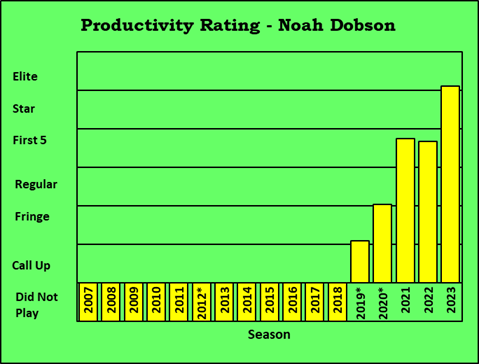
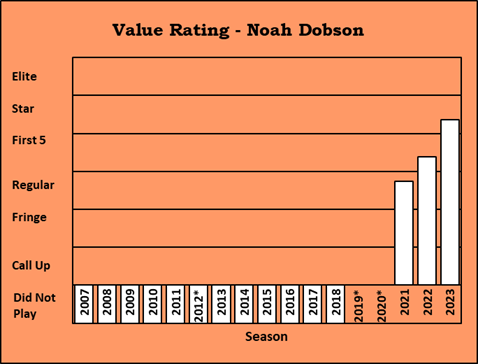
The Career Productivity Rating Chart shows his big improvement this season. After two good seasons (PR-First5 is equivalent to a #1 or #2 defenseman), Dobson leaped into the PR-Elite category this season.
His Career Value Rating Chart shows consistent and significant progress. The increase in his 2022-23 Value Rating came about because he had a good 2022-23 season, and his 2019-20 season was not used. The increase in 2023-24 has similar reasons for the increase, those being a good recent season and dropping a lower-rated earlier season.
While Dobson’s 2023-24 season was a PR-Elite season, he was rated a VR-Star. To move to the VR-Elite level, his 2024-25 season will have to be as good as his 2023-24 season.
Most Valuable Player, 2023-24
It cannot be a surprise that the MVP for 2023-24 is Connor McDavid (F, EDM).
In second and third place are Cale Makar (D, COL) and Nathan MacKinnon (F, COL). Yes, being teammates helped them achieve higher ratings, just as McDavid was helped by having Draisaitl as a teammate.
Auston Matthews (F, TOR) was in fourth place by a very slim margin: MacKinnon’s VR-Score was 12.27 while Matthews had a VR-Score of 12.24. In many of the earlier seasons, Matthews would have been the MVP with that VR-Score.
Most Valuable Players, 2008-09 Through 2022-23
As I was figuring out who the MVP was for 2023-24, it struck me that I had never looked at who led the league in Value Rating in other seasons: I have always concentrated on Productivity Rating. I should have looked at this earlier!
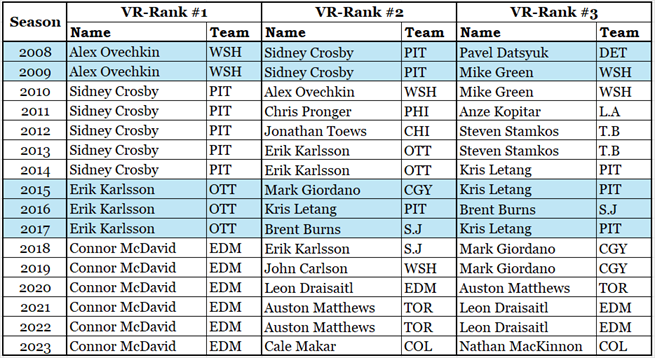
The table shows the top three players in Value Rating from each season since 2008-09. The reason there are no Value Rating leaders for 2007-08 is that it was the first season of the rich-statistics era, so nobody could have met the games-played criterion.
Now, what surprised me was the dynasties of MVPs. I had thought that players would pop in and out of the top spot, as there are usually two or three players who are exceptionally good in any season. But that has not happened (yet). Every player that became the MVP held the title for at least two consecutive seasons.
Let’s look at the Value Rating and Productivity Rating charts of the four MVPs. Alex Ovechkin (MVP 2008-09 through 2009-10) goes first.
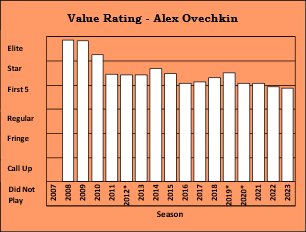
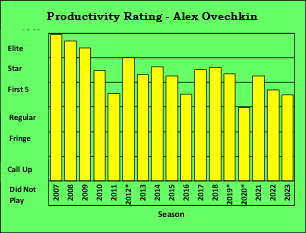
Ovechkin was VR-Elite from 2008-09 through 2010-11. In his career, he has had three PR-Elite and nine PR-Star seasons. Both his VR and PR charts are trending downward because that’s what happens when a player ages.
What makes a fabulous player a fabulous player is both the heights they achieve and the pace at which their skills decline. The better players stay good longer and decline more gently. Ovechkin is declining gently.
Next up is Sidney Crosby, MVP from 2010-11 through 2014-15.
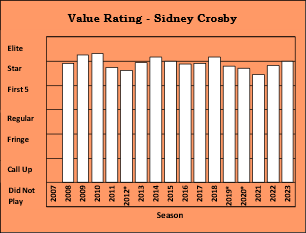
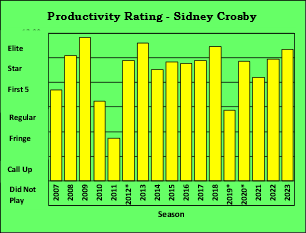
Given the ups and downs of Crosby’s seasons, his Value Rating is remarkably consistent. He has had five VR-Elite seasons and eleven VR-Star seasons.
Injuries have hurt Crosby’s career. Over his career, he has played 150 fewer regular season games than Ovechkin. Injuries result in fewer games played, and fewer games played results in lower PR-Scores, and lower PR-Scores result in lower VR-Scores. It’s a nasty set of consequences.
Even if you don’t like the Penguins, you have to like Crosby.
Crosby’s reign as MVP was ended by the best defenseman to have played in the rich-statistics era: Erik Karlsson.
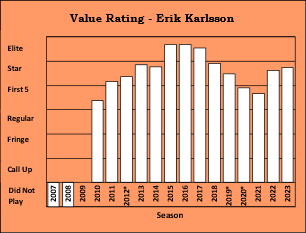
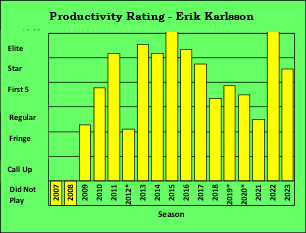
But for an injury inflicted on Karlsson in 2012-13 by an utterly useless turd of a player, Karlsson probably would have been MVP one or two seasons earlier. The injury resulted in lower VR-Scores for Karlsson in three seasons (2012-13 through 2014-15).
I had the great pleasure of watching Karlsson when he was at his best while he was with the Ottawa Senators. He was an electrifying player. My saddest day as a fan of the Senators was the day they traded Karlsson.
Speaking of incredible players, Erik Karlsson was supplanted as MVP in 2018-19 by Connor McDavid, who has held the honour since.
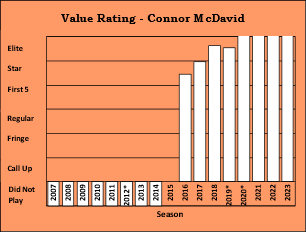
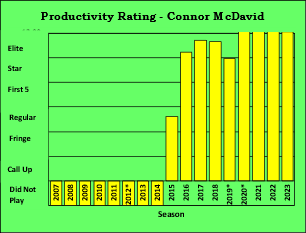
Not only have McDavid’s last four seasons been “off-the-chart” Productivity Rating seasons, but they were also off-the-chart Value Rating seasons.
McDavid is truly a generational talent.
Summary
People who disagree with these results could call Value Ratings into question, or they could take a more generic approach and question using any statistics to decide award winners.
Are Value Ratings accurate? I could point out that the accuracy of VR-Score is proven because Ryan Reaves (F, TOR) ranks 575th out of 576 players who qualified for Value Ratings in 2023-24, but I won’t do that because I am really trying hard to not write something snarky about Ryan Reaves in every article.
While I do not believe that Value Ratings are perfect, I believe they are accurate. Accuracy for VR-Scores can only be determined subjectively. Are the correct players at the very top of the list? Are the players in the next level of VR-Scores really good, but not the absolute best?
At the top of the VR-Score list are McDavid and Makar and MacKinnon and Matthews. The next level has Adam Fox, J.T. Miller, Mikko Rantanen, Mitchell Marner,Nikita Kucherov, Quinn Hughes, Rasmus Dahlin and Roman Josi.
To me, that indicates that VR-Scores accurately identify the values of players.
Critics who generally do not want to use statistics to determine award winners are mostly in one of two camps: they believe the formulas being used are imperfect, or they believe that the statistics do not perfectly capture the game of hockey. Basically, these people prefer to use the voting of sportswriters over statistics because the statistics are not perfect.
Wait a minute. If the problem is a lack of perfection, why on earth would they accept the voting of sportswriters? Do they not remember that some idiot of a voter put Connor McDavid in fifth place for MVP in 2022-23? Many times, in the last decade, the voting of sportswriters has led to controversial decisions.
I prefer awards based on statistics. Every player is treated fairly, and every game each player plays is considered. The statistics do not care who wins, they just show us who wins.
Related Articles
Introduction to Value Rating
2023-24 Post Season Awards
